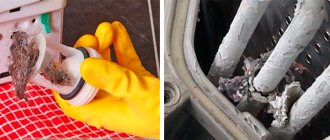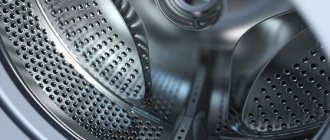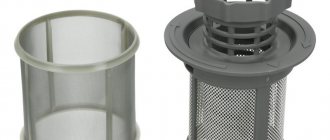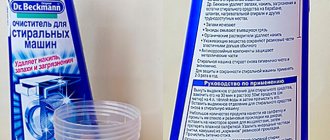Reasons for cleaning equipment
Dishwasher manufacturers strongly recommend carrying out cleaning procedures at least once every 3-4 weeks, but housewives do not always adhere to this rule and carry out appropriate measures only if absolutely necessary. You can’t blame people, because the frequency of cleaning the device from dirt depends on the operating characteristics of the machine. Urgent procedures are necessary if an unpleasant odor appears in the tank.
The number of cleanings is influenced by the following factors:
- Device usage schedule. Some housewives turn on the machine every day, others wash a small amount of dishes by hand; the device is used only when there is a significant accumulation of plates and cups.
- The degree of contamination of cutlery. Salads and vegetable fats are much easier to clean than animal fats and burnt food. Some of these contaminants accumulate in large quantities under the rubber seals.
- Temperature regime for washing dishes. The user himself selects the required temperature; the lower it is, the faster the device will clog.
- The amount of active substance in detergents. The more aggressive the solution, the longer the dishwasher will last. At the same time, a large amount of household chemicals used can harm human health.
Before you clean the dishwasher from grease, you need to decide on the operation of the unit. If the user receives clean, squeaky dishes at the output, then the device is working normally. If dark stains or traces of dirt remain on the cups and plates, it is necessary to take urgent measures to care for the equipment.
Most users do not know how to clean the inside of a dishwasher. To carry out such work, you will need a soft kitchen sponge and a toothbrush. Using this tool, filters and impellers, as well as the space between the seals, are cleaned. In addition, you need to look at the walls of the chamber and the container for storing dishes. There should be no mold in these areas. If such defects are present, problem areas are cleaned using detergents. At the final stage of work, the machine is started.
When is cleaning needed?
Machine maintenance is necessary for a number of reasons:
- frequency of cleaning: the more often the device is used, the more intensively the dirt is formed;
- degree of cleanliness of dishes: if food residues are not removed before placing them in the basket, layers of fat and dirt will form faster; for this reason, dishwasher manufacturers recommend placing in the tank only plates and pans that are as free of food as possible;
- temperature regime: if cool water is used, fatty components do not dissolve, but linger on the grill, tank surfaces and internal components of the unit; if you regularly clean at low temperatures, it will be more difficult to remove plaque;
- the use of non-aggressive detergents also contributes to the deposition of complex contaminants on surfaces, however, the use of toxic chemicals can be dangerous; in addition, the use of aggressive agents, although it provides intensive cleaning of the PMM, has a negative effect on the mechanism of the unit;
- Using unsuitable rinse aid, salt and detergent.
The dishwasher should be cleaned if an unpleasant odor appears when opening the door and does not disappear after the end of the operating cycle of the device. In addition, due to complex contamination, the unit itself may break. This occurs when the device is not maintained or when the machine is cleaned rarely and using inappropriate products. Sometimes some components need to be replaced. The cost of repairs can be high. For this reason, maintenance should be performed at least once a month.
Dishwasher care instructions
Household appliances must be wiped both outside and inside immediately after removing cutlery, plates, cups.
Forms of release of household chemicals
Currently, manufacturers offer cleaners in three variations:
- powder is a more familiar form of release for most users, which is cheap and has good efficiency. It is not difficult to dose the product; on the other hand, there is a risk of spilling it past the compartment. Another disadvantage is the likelihood of leaving scratches on delicate dishes;
- gel - the most gentle and safe preparations that have a gentle and gentle effect on any materials. They provide excellent results and do not contain abrasives or other hard components;
- tablets are a more expensive but convenient option. One tablet is enough for one cycle. Such a product cannot be spilled or spilled by inhaling toxins. On the other hand, one wash is not always enough to completely dissolve the tablet, which is why their consumption is not always rational.
Frau Schmidt Gel Tablets
Cleaning procedure
To prevent dirt from accumulating on the doors, they are regularly washed with a wet cloth or napkin soaked in a soapy solution.
You need to wipe the machine, the body of which is made of stainless steel, with a special cleaner, and the control panel with a dry cloth. Drops of liquid should not fall on the buttons.
Washing the strainer
Once a week, it is recommended to remove the shelves from the chamber, soak them in detergent and dry them with a soft cloth. Every 7 or 8 days, it is necessary to remove the mesh filter from the lower basket, soak this part in a soapy solution, rinse with cool water, and return it to its place.
Cleaning the blades
Food residues and hard liquids clog the holes through which the soap solution enters the dishwasher. Clogged blades that supply water must be removed and cleaned with wire, rinsed under the tap.
Processing of seals
In order for household appliances to perform their functions for a long time and efficiently, it is worth purchasing a special chemical composition in the store, which is applied with a sponge to the seal that is installed on the dishwasher door.
Mechanical cleaning of components, parts and surfaces
The more often the dishwasher is used, the more often it needs to be cleaned. For example, when using PMM daily, experts recommend cleaning it every 12-15 days. In addition to food residues, scale can also accumulate in the machine, since the hardness of the water in the tap water is often quite high. These factors must be taken into account to ensure that your kitchen assistant serves for a long time and without failure.
If you don't clean your dishwasher, it will give off an unpleasant odor.
You can clean your dishwasher from grease and scale using both well-known folk remedies and chemicals specifically designed for PMM.
Removing dirt from filters
Each dishwasher has a combined coarse and fine filter. It is located at the bottom of the chamber, next to the impeller of the sprayer (hereinafter also referred to as the sprayer). Filter elements need to be regularly cleaned from dirt and food debris. During daily use of the PMM, the filter itself must be cleaned after 5-6 operating sessions, at least.
In addition to the filter, you need to clean the mesh that frames it from dirt.
Cleaning the filter element is simple:
- Turn off the dishwasher.
- Remove the lower basket from the chamber and use a sponge to remove any remaining liquid on the bottom. If there is dirt on the framing mesh, remove it (see photo).
- Locate the filter near the spray nozzle and turn it counterclockwise 90°. In some models, the filter cup simply needs to be pulled up.
- Check the hole under the filter for dirt and solid food debris. If there are any, remove them from there; any remaining water should also be removed with a sponge.
- Check that the pump impeller rotates well. To do this, unscrew the screw and remove the cover covering it. Do not allow small objects to get under the impeller and jam it.
- Wash all filter components in warm water and a detergent that can dissolve grease. In case of severe contamination, use vinegar or citric acid. It is necessary that the fine mesh cells are free from dirt and grease.
Filter glasses for coarse and fine cleaning in PMM Bosch
In addition to the drain filters, it is necessary to regularly check the meshes of the inlet filters located at the entrance to the PMM housing and at the entrance to the inlet hose from the water supply side. These parts prevent rust from pipes and other dirt from entering the machine.
Cleaning spray nozzles
No matter how well the filter reduces the degree of water contamination, small particles can still pass through the fine mesh. If you add limescale to them, the total contaminants can clog the holes in the spray arms. Therefore, their visual inspection and periodic cleaning are also necessary.
Sprinkler nozzles that need to be checked and cleaned from time to time
The quality of washing kitchen utensils depends on the cleanliness of the holes in the rocker arms. Therefore, periodically perform the following procedure:
- Remove the upper basket from the chamber to which the spray arm is attached.
- Remove the spray arm by pulling out the latches.
- Lift out the lower basket and remove the lower spray arm.
- Remove grease deposits by washing the blades with detergent and water. Check the condition of the holes by running a stream of water into the nozzles. Clean clogged holes with a toothpick or any similar object.
- Install in reverse order.
Removing the Upper Sprinkler Arm
If you have difficulty removing the sprinklers, use the instructions for your PMM.
Removing dirt from baskets
The ingrained deposits of fatty deposits and scale are not so easy to wash off from the surface of the baskets. To make your task easier, use one of the commercially available PMM cleaning products (they will be discussed below).
Do the following:
- Place the baskets in a large container so that they fit entirely.
- Pour boiling water over them and add cleaning product.
- Leave to soak until the water cools down.
- Now use a soft brush and remove any remaining softened dirt.
Cleaning the basket from dirt with a toothbrush
Cleaning the dead space of the door and its seal
Unfortunately, the design features do not allow the dirt to be properly washed off from the bottom of the inside of the door. Therefore, deposits of food waste accumulate there. To get rid of them, wipe the area with a sponge soaked in soapy water, then wipe dry and rinse with vinegar to kill bacteria.
“Dead” zone on the inside of the door, which also requires regular maintenance
If the rubber seal framing the door is not very dirty, it is enough to wipe it with a cloth moistened with a solution of a preparation specially designed for servicing PMMs. Old dirt can be removed with a soft brush, such as a toothbrush. Other common products, such as soap, vinegar or citric acid, are not recommended because they may damage the elastic material.
Cleaning and disinfecting the chamber
To clean the inside of the dishwasher, treat the entire interior surface of the dishwasher with a sponge soaked in a solution of dishwashing detergent that dissolves grease deposits well. Pay special attention to hard-to-reach corners where the most dirt accumulates. You can use dishwasher care products.
Cleaning the dishwasher chamber
In order for an unpleasant odor to appear in the machine, the door must be opened regularly for ventilation. In particularly advanced cases, bleach will help get rid of mold. But it must be used with extreme caution, since this composition is chemically active. It can even damage the metal inside the PMM, not to mention the sealing gaskets and plastic structural elements.
Traditional ways to remove scale
The procedure for cleaning the washing chamber equipment from salt deposits begins with manually wiping the impeller and spaces under the seals, checking for traces of mold under the rubber band or on the dish basket. After this, you can prepare a reagent for removing scale from the heating element, circulation pump, sprayers, and pipes by turning on the idle (without utensils) operating mode of the PMM. If lime deposits are found in the initial stage of formation, folk remedies are used.
Washing with citric acid solution
The powder of this substance is available in every kitchen; the required amount depends on the accumulated scale. With a small layer of deposits, 100 g is enough, in advanced cases - up to 250 per procedure. Procedure:
- pour 150–200 g of citric acid powder into the bottom of the machine’s hopper or into the dispenser compartment;
- turn the device on to normal washing mode at a temperature of 90ºС;
- in the middle of the cycle, pause the program for 20 minutes: you need to give time for the reaction of dissolving lime formations in the acidic composition;
- continue to operate the dishwasher until the cycle is completed.
After stopping, the machine is opened and checked: the cleanliness of the spray holes of the rocker arms, the presence of remains of lime fragments in the door cuff, inside the hopper. If found, remove and wipe with a soft cloth. You can repeat the treatment after 2-3 days with half the dose of powder on a short cycle.
Cleaning with vinegar diluted in water
Wear gloves when working with it. Wipe the internal surfaces of the washing chamber with a sponge soaked in the reagent. Further actions are performed as in the case of using citric acid:
- pour 2 cups of vinegar with a concentration of 9% into the bottom of the bunker;
- turn on the wash in hot water mode, pause halfway through the cycle for 20–30 minutes, then continue the process;
- At the end of the program, restart the machine for rinsing to wash away any remaining vinegar.
The procedure ends with wiping the camera and its equipment with a cloth soaked in a weak solution of vinegar. After this, you need to wipe it with a dry cloth and leave the door open to remove the smell.
Borax against limescale
Used to clean metal surfaces before soldering. Works well when removing scale from dish baskets, walls and washing chamber doors. The actions are:
- Apply borax to a damp sponge and cover the limescale stain with a thin layer. There is no need to scrub off the deposits; leave the PMM in this state for 20 minutes.
- Set the program with the highest water heating and start the machine.
- Inspect the chamber after completing the cycle; if there are any remaining borax or scale, wipe them off with a sponge. Re-enable idle mode.
Removing deposits with baking soda and peroxide
This mixture allows you to successfully get rid of scale on the heating element and inside the washing chamber of the device. Prevention is carried out in 2 stages: preparing the reagent, washing the hydraulic circuit of the PMM. Sequence of operations:
- pour 400 g of baking soda into a container, add 3 tbsp. spoons of hydrogen peroxide, stir;
- pour a little (20–30 drops) of essential oil into the resulting mass for a pleasant smell, roll it into a ball, and place it on the bottom of the hopper;
- select the long mode, start the wash without loading dishes.
Care instructions
You can reduce the likelihood of scale formation in the dishwasher at the stage of its selection. When purchasing, you need to pay attention to whether the machine is equipped with a function to protect against the formation of lime deposits, and whether there is a water hardness regulator. In any case, caring for the PMM is necessary, here are the procedures that must be performed:
- Use special dishwasher salt - it is made by purifying the table variety with the addition of other reagents. Under its influence, the composition of water changes, which slows down the formation of scale.
- Use the machine regularly for its intended purpose. Rarely turning on the PMM does not improve the performance of the device: it needs to be started at least once every 3 days.
- Use detergents that contain anti-scale additives. Those powders and gels that soften water are also suitable.
- Periodically carry out dry cleaning using descaling agents. The recommended interval is once every 1–3 months. The harder the water in the region, the more often prevention is carried out.
The number of scheduled cleanings can be reduced by installing devices for softening and filtering water coming from the central water supply system on the inlet main. The regularity of prevention is determined by the user of the machine, based on the brand of PMM and the composition of the local water.
Video
What tools should be used
How to clean your car depends on the type of contamination. Home appliance stores sell special compounds for removing grease, food residues or scale, and home remedies are also used.
Mold
If there is excessive humidity or lack of normal ventilation in the room, a specific smell sometimes appears in the dishwasher. Pathogenic fungi settle on drain filters, pipes, and hoses. Mold forms in places where they accumulate.
To cope with microorganisms, infected areas are treated with vinegar or soda. To remove the smell, the hoses are washed with a special preparation. To disinfect and clean the machine:
- A glass of vinegar is placed on the top shelf.
- Set the washing mode, select a high temperature.
- Soda is poured into the hopper and the cycle is repeated.
The equipment is not closed for several days. To prevent mold from appearing on parts and hoses, you should not leave wet dishes in the machine for a long time, but you should regularly clean the drains and filters and use high-quality detergents.
Rust
Bleach effectively kills mold, but worsens the condition of metal parts. Not only pathogenic fungi harm the dishwasher, but also rust.
To get rid of it, the chamber, components and parts are treated with an anti-corrosion agent, and a filter is installed at the inlet, which protects against the entry of metal impurities through the pipes.
Scale
Cutlery and dishes are better washed from grease and dirt in warm water. Heating elements begin to fail to cope with their functions if scale forms on them, which you can remove yourself.
To clean the car:
- The glass is filled with vinegar and placed on the top shelf.
- Start the cycle.
- Pour a cup of soda into the bottom of the equipment.
When the water temperature rises, a pause is set. Within 60 minutes the scale will dissolve. After completing the program, wipe the inside of the machine with a dry cloth. You can remove odor, grease and dirt in another way. Two glasses of lemon juice are placed on the shelf, and 300 g of acid is poured into the washing gel compartment. Set to intensive mode. After finishing, the car is washed with water.
Borax scale is cleaned well and quickly, the internal parts of household appliances are wiped with the preparation, then 1 part of this powder is dissolved in 5 parts of clean water, poured into a tray and a wash cycle is selected.
"Finish"
To remove limescale deposits that form on dishwasher parts, you should purchase a Finish brand product. The drug forms a protective film that repels dirt. When the composition is applied for 4 months, fat does not stick to the surface, and scale does not form on the heating elements.
Sormat
The German manufacturer Henken supplies the markets of many countries with a phosphate-free product that will allow you to clean your dishwasher from plaque. One tablet is placed in the compartment along with the gel or powder, the other is placed on the bottom of the device and a mode is selected. The drug must be used carefully, since it contains biologically active enzymes that can cause allergies.
Topper
The product, which has an effective formula, performs various functions and contains additives that prevent scale from forming. The tablets are loaded into the compartment for washing gels. They extend the life of household appliances, protect glass, stainless steel, and silver products from dirt, remove plaque, and add shine.
How to clean the device using folk remedies
One of the most unpleasant moments in the operation of dishwashers is scale on internal parts and surfaces, which appears as a result of using hard water.
Let's see how you can clean the mechanism quickly, efficiently and at low cost.
Applications for cleaning surfaces at home are ordinary products available in the kitchen, or those that can be easily purchased in pharmacies.
Cleaning with citric acid
Using citric acid as a cleaning agent, you need to:
- pour 200 grams of lemon into the hopper;
- set a standard washing program and run the machine to nothing;
- In the middle of the cycle, stop the machine for twenty minutes, then continue the program until completion.
This method has excellent results, but has some unpleasant aspects - citric acid can destroy the gaskets. Therefore, this method of cleansing should be approached extremely rarely, unless there is another alternative.
Vinegar
You can get rid of plaque with vinegar. Although this is not considered a 100% safe method, it is also quite effective. To clean, you need:
- pour two glasses of vinegar into the bottom of the hopper;
- wipe the inner walls of the tank with a kitchen sponge, first wearing rubber gloves;
- start the washing process;
- halfway through the cycle, turn off the machine for thirty minutes, then resume the program again;
- after turning off the cycle, run the unit in express mode until the vinegar solution is completely removed from the system.
Borax cleansing
To remove salt deposits from the internal surfaces of the unit, apply a small amount of borax to a damp kitchen sponge and cover the internal surface of the mechanism with it. There is no need to rub or clean, it is better to wait twenty minutes. Then select the program with the hottest water and turn on the machine.
At the end of the cycle, the filter is washed and the surface is inspected to see if there is any borax remaining on them. If there are residues, wipe these places and start the machine again.
Cleaning with baking soda and hydrogen peroxide
Descale the heating element of the dishwasher using a simple solution:
- mix 400 grams of baking soda and 3 tablespoons of peroxide;
- roll up a ball and load it onto the bottom of the inner chamber;
- start idling for the longest program;
- wash the filter and restart the program.
Physical cleaning
If the methods provided do not solve the DIY cleaning program, you can try cleaning it yourself (mechanically) to remove old lime deposits.
However, if the internal system is already clogged with limescale, and the water supply to the machine is limited, then no means will help. To clean it, you will have to contact specialists who will disassemble the car and remove plaque from all parts.
If it is easier for the consumer to clean using factory-made products, then the market today offers a large selection of good cleaners for dishwashers.
Rating of the best dishwasher cleaners
The choice of detergent composition should be approached carefully. It should not only wash dishes well, but also not damage rubber components, which require delicate and careful care. Affordable price is also an important factor when choosing household chemicals, because excessively expensive products with frequent cleaning can negatively affect your material well-being.
Finish Calgonite Fusion Power
The cleaner works on stubborn stains on dishwasher components.
Pros:
- Elimination of limescale.
- Antibacterial and antifungal action.
- Long-lasting effect - one cleaning lasts for 2-3 months.
- Convenient format - in order to use the product, you just need to place it in the grilles of the device.
Minuses:
- Persistent chemical smell - not suitable for people sensitive to strong aromas.
- In order to rinse the equipment from chemicals after cleaning, you will need to start the device again.
- High price - packaging designed for 1 use costs 200-300 rubles.
Uniplus
Uniplus is available in a highly concentrated gel format.
Some More Great Cleaners
The list of good dishwasher products is not limited to the rating given above. There are other worthy drugs, but they are much more difficult to find on sale. Thus, buyers praise Rinnova Lavastoviglie (Italy), but this inexpensive and high-quality product is still rarely found in hardware stores.
You can find good reviews online about Reinex Spülmaschinen Pflegereiniger . This is a phosphate-free liquid product based on citric acid without adding fragrances. Its advantages are efficiency, safety and environmentally friendly composition. After disinfection, the car tank does not smell.
Excellent cleaning, a slight pleasant smell and normalization of the dishwasher's operation are the result of caring for equipment using Pirkka Astianpesukoneen puhdistustabletti . The package contains 6 tablets in a water-soluble coating. They last for six months of use. When cleaning, make sure that there are no dishes left in the machine, otherwise delicate cutlery may be damaged.
The PMM care product Pirkka Astianpesukoneen puhdistustabletti is compared with Finish brand products. It copes just as well with dirt, but smells weaker and more pleasant.
HG powder cleaner has proven itself well . The product is used with equal success to care for dishwashers and washing machines, so it is in demand among housewives who do not want to buy different products. The powder is packed in a cardboard box. It is convenient to open and dispense.
Finnish cleaner At Home Clean Dishwashing Machine cleans your dishwasher to a sparkling shine. The price is reasonable. You can save money by using half a tablet, and this will not affect the quality of cleaning. The disadvantages include difficulties in purchasing the composition. Most often you have to order online. An important nuance: the purifier is effective only at high water temperatures.
Cleaning the dishwasher with liquid W5 Dishwasher Cleaner . You can't expect a super effect, but considering the cost of the bottle, you don't count on it. The composition does a good job of washing away grease and scale, but you can still find traces of dirt under the rubber bands.
The only, but not unimportant, advantage of W5 Dishwasher Cleaner is its low price compared to TOP cleaners. The product is good, but not perfect
There are references to the product Frisch-Activ . Some housewives really like it because of the low price, while others are dissatisfied and note the poor quality of cleaning and disinfection of the dishwasher.
You should think twice about buying it. This is an option for those for whom it is more important to save money and achieve at least some result. If efficiency is a priority, then it is better to purchase a different composition.











